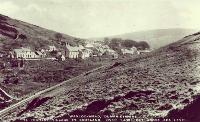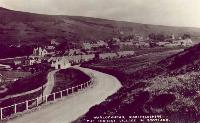Ordnance Gazetteer of Scotland, Francis H. Groome, 1885
Leadhills, a mining village in Crawford parish, S Lanarkshire, on Glengonner Water, 1 1/4 mile NNE of Wanlockhead, 5 miles WSW of Elvanfoot station, 7 SSW of Abington, and 45 SSW of Edinburgh. The highest village in Scotland—1250 to 1412 feet above sea-level—it is backed to the S by Wanlock Dod (1808 feet) and Lowther Hill (2377), and straggles down both sides of its upland glen for nearly 3/4 mile. Since 1861 nearly every cottage has been either rebuilt or repaired; and their roofs of Welsh slate, their whitewashed walls, and their pretty flower-borders have greatly improved the aspect of the village. The landscape around is bleak, but the neighbouring summits command magnificent views from Cumberland to Ben Lomond, and from the Pentlands to Ailsa Craig, Arran, and Jura. Lead-mining in the vale of Glengonner Water is heard of as long ago as 1239, and possibly was carried on in the time of the Roman domination. The Romans, at all events, had several camps in the neighbourhood, and led two of their military roads to a junction within the parish; and, as they certainly worked lead-mines somewhere in Great Britain, they are more likely to have worked them here than in any other locality. The ores, however, were little known till 1517, nor were they begun to be vigorously and systematically worked till the beginning of the 17th century; but from then on until now they have continued to be worked with little interruption. In 1810 the Leadhill mines produced about 1400 tons of lead, worth at the then current price more than £45,000; but they afterwards so declined that the annual output was only from 700 to 800 tons. Since 1861, however, they have much revived under the Leadhills Mining Company, the outputs of dressed lead in 1878 and 1881 being 1350 and 1805 tons, containing on an average from 6 to 12 oz. of silver per ton. The ores of Leadhills, which belong to the Earl of Hopetoun, since 1842 have been worked with the aid of steam power and of improved smelting apparatus ; and in 1868 some 2 1/2 miles of underground railway were formed at a cost of £7213. The goldmines of Crawford Muir are noticed under Lanarkshire (p. 462, col. ii.). Leadhills has a post office under Abington, with money order, savings’ bank, and telegraph departments, an hotel, a good water supply, a public school, an excellent public library (1741), a Good Templar lodge, a brass band, a volunteer corps, a curling club, and fairs on the second Friday of June and the last Friday of October. The Ha’, a shooting-lodge of the Earl of Hopetoun, is a large old mansion ; one of its two wings has served since 1736 as an Established place of worship, and contains 500 sittings. The poet, Allan Ramsay (1686-1758), was a son of the superintendent of the mines, and at Leadhills passed the first fifteen years of his life; other natives were James Taylor (1753-1825), who suggested the power of steam in inland navigation, and James Martin, M-D. (1790-1875), who served as a surgeon in the Peninsular War. In the churchyard, too, is buried John Taylor (1637-1770), who passed the last 37 years of his life at Gold Scars, and worked as a miner for upwards of a century. Leadhills was visited by Thomas Pennant (1769), by Coleridge, Wordsworth, and his sister Dorothy (1803), by Miss Martineau (1852), and by Dr John Brown (1865). The quoad sacra parish, constituted in 1867, is in the presbytery of Lanark and synod of Glasgow and Ayr; its minister’s stipend is £120. The public school, with accommodation for 216 children, (1881) an average attendance of 180, and a grant of £166, 9s. Pop. of village (1769) about 1500, (1831) 1188, (1861) 842, (1871) 1033, (1881) 1023, in 243 houses; of q. s. parish (1881) 1081, of whom 7 were in Crawfordjohn.—Ord. Sur., sh. 15, 1864. See eight articles, original or quoted, in vols. i. and iii. of Irving’s Upper Ward of Lanarkshire (Glasg. 1864); pp. 18-22 of Dorothy Wordsworth’s Tour in Scotland (Edinb. 1874); ‘The Enterkin’ in John Brown’s Leech and other Papers (Edinb. 1882); and the Rev. Dr J. Moir Porteous’ God’s Treasure House in Scotland (Loud. 1876).
Wanlockhead, a mining village in the NE corner of Sanquhar parish, NW Dumfriesshire, 1 1/2 mile SSW of Leadhills, 6 1/2 miles WSW of Elvanfoot station, 8 1/2 SSW of Abington, and 8 1/2 ENE of the town of Sanquhar. It lies, 1350 feet above sea-level, at the head of the lonely glen of Wanlock Water, in one of the bleakest scenes of the Southern Highlands, the chief of the big, smooth hills that rise around it being Wanlock Dod (1808 feet), Green Lowther (2403), Lowther Hill (2377), and Stood Hill (1925). The mines, which alone could people so cheerless and elevated a region, are continuous with those of Leadhills on the Lanarkshire side of the frontier; and jointly with them, they extend to a circumference fully 4 miles in diameter. The Wanlockhead mines were worked as early as 1512. Gold was the primary object of search, and has not yet ceased to be found. Sir James Stampfield opened the lead mines about the year 1680, and worked them on a small scale till the Revolution. Matthew Wilson obtained in 1691 a 19 years’ lease, and successfully worked the vein called Margaret’s; whilst a mining company, having procured in 1710 a 31 years’ lease, commenced to smelt the ore with pit-coal, and partially worked the three veins of Old Glencrieff, Belton, and New Glencrieff, the last of which only proved compensating. The new and large Friendly Mining Society formed in 1721 a co-partnership with the smelting company, and got 15 years added to the 20 which had yet to run of the lease. The two companies jointly worked all the then known four veins for 6 years, when they separated and pursued their object in different localities. But in 1734 both companies resigned their lease; and Alexander Telfer became lessee for the next 21 years. He worked the mines vigorously, and made a richly compensating discovery of a large knot of lead. In 1755, a new company, with Mr Ronald Crawford at its head, became lessees of the whole mines. Their first lease was only for 19 years ; but they afterwards obtained an act of parliament extending it to 1812, and, previous to that year, they were granted a new lease to expire in 1842. The new company were enterprising and eminently successful; they discovered new and rich ramifications of the veins; and, when workable ore could no longer be found, they erected a series of steam engines, some on the surface, and some under ground, to carry off water from their borings beneath level. So successful were the operations that during 50 years 47,420 tons of lead were raised. From 1842 the Duke of Buccleuch retained the mines under his own management; and they are now worked by means of four powerful hydraulic engines and one steam engine. All the most recent mining improvements have been introduced; and the process of refining the bars for the separating of the silver from the lead is carried on simultaneously with the smelting. The present yearly average of the output is 1000 tons of lead and 5750 ounces of silver. Along with the lead ore or lead glance are small quantities of manganese, ochre, blende, brown hematite, copper pyrites, green lead ore, white lead ore, and lead vitriol. A chapel, built in 1755 by the mining company at a cost of not more than £70 or £80, in 1848 was superseded by a new church with 325 sittings, built and endowed by the Duke of Buccleuch, and raised to quoad sacra parochial status in 1861. It was long ere a site could be got for a Free church, and meanwhile Drs Chalmers, Guthrie, Candlish, etc., preached on the hill-side; but at length a church, with 400 sittings, was opened in 1859. Wanlockhead has also a post office, a reading society (1756), friendly and co-operative societies, an Oddfellows’ Lodge. a young men’s association, a school, etc. Pop. of village (1831) 675, (1861) 743, (1871) 772, (1881) 788; of q.s. parish (1881) 854. – Ord. Sur., sh. 15, 1864. See the Rev. J. Moir Porteous, D.D., God’s Treasure House in Scotland (Lond. 1876).

